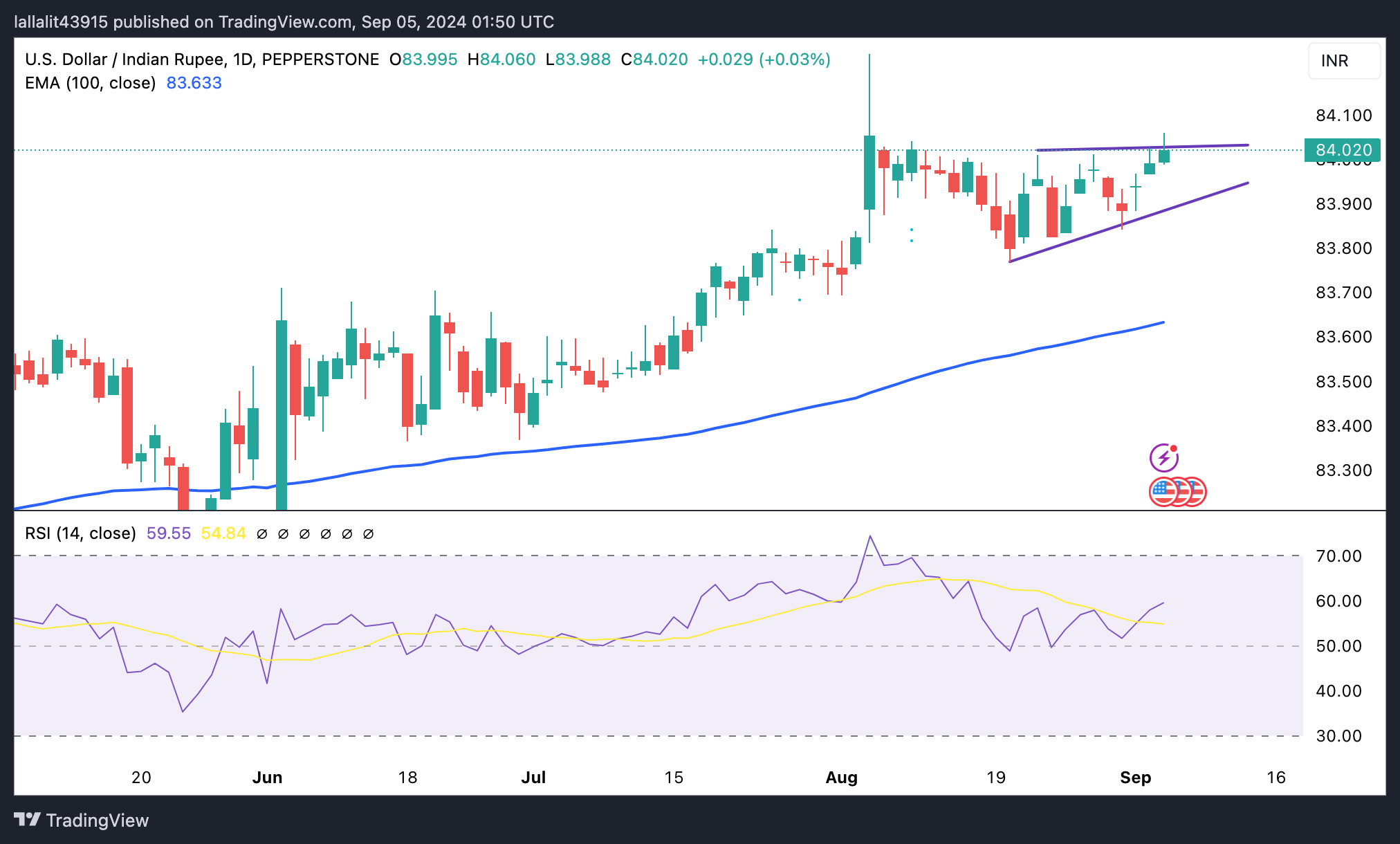USD/INR edges higher ahead of US PMI data

- Indian Rupee weakens in Thursday’s early Asian session, pressured by a sell-off in Indian equities.
- RBI’s intervention and lower crude oil prices might cap the INR’s downside.
- Investors await the US ISM Services PMI, which is due later on Thursday.
The Indian Rupee (INR) extends its downside on Thursday despite the weaker US Dollar (USD). A sell-off in domestic equities tracking global cues weighed on the INR, dragging the local currency to near all-time lows. However, the possible intervention by the Reserve Bank of India (RBI) through USD sales might prevent the Indian Rupee from breaching the 84 mark. Additionally, a fall in crude oil prices could help limit the INR’s losses as India is the world’s third-largest oil-consuming and importing nation.
The US ISM Services Purchasing Managers Index (PMI) is due later on Thursday, which is estimated to ease to 51.1 in August from 51.4 in July. On Friday, the attention will shift to the US Nonfarm Payrolls (NFP) for August. This event might offer some cues about the size and pace of rate cuts by the Federal Reserve (Fed) this year.
Daily Digest Market Movers: Indian Rupee seems vulnerable ahead of US NFP data
- The HSBC India Services Purchasing Managers Index (PMI) improved to 60.9 in August from 60.3 in July, above the market consensus of 60.4. This figure registered the highest since March.
- “The Indian rupee was again stopped near 83.9750, its lowest closing, possibly by RBI as it sold dollars to ensure it remains a touch away from the psychological level of 84.00. Risk-off sentiments ensured that markets kept buying dollars and RBI supplying them,” said Anil Kumar Bhansali, head of treasury and executive director at Finrex Treasury Advisors LLP.
- Job Openings and Labor Turnover Survey showed that available positions fell to 7.67 million in July, compared with 7.91 million openings (revised from 8.1 million) seen in June, the Labor Department reported on Wednesday. This figure came in below the market consensus of 8.1 million.
- Atlanta Fed President Raphael Bostic stated on Wednesday that he is ready to start cutting interest rates even though inflation is still running above the US central bank’s target.
- The markets are now pricing in nearly 57% chance of a 25 basis points (bps) rate cut by the Fed in September, while the odds of a 50 bps reduction stands at 43%, according to the CME FedWatch tool.
Technical Analysis: USD/INR’s outlook remains positive
The Indian Rupee softens on the day. According to the daily chart, the USD/INR pair remains stuck within an ascending triangle. Nonetheless, the constructive view of the pair prevails as the price holds above the key 100-day Exponential Moving Average (EMA), with the 14-day Relative Strength Index (RSI) pointing higher above the midline near 59.55.
A major resistance level emerges at the 84.00-84.05 region, portraying the 84.00 psychological figure, the upper boundary of the triangle and the high of September 4. Sustained trading above this level might set USD/INR up to 84.50.
On the downside, the ascending triangle support near 83.90 acts as an initial support level for the pair. A breach of the mentioned level could revisit the 100-day EMA at 83.63.
Indian Rupee FAQs
The Indian Rupee (INR) is one of the most sensitive currencies to external factors. The price of Crude Oil (the country is highly dependent on imported Oil), the value of the US Dollar – most trade is conducted in USD – and the level of foreign investment, are all influential. Direct intervention by the Reserve Bank of India (RBI) in FX markets to keep the exchange rate stable, as well as the level of interest rates set by the RBI, are further major influencing factors on the Rupee.
The Reserve Bank of India (RBI) actively intervenes in forex markets to maintain a stable exchange rate, to help facilitate trade. In addition, the RBI tries to maintain the inflation rate at its 4% target by adjusting interest rates. Higher interest rates usually strengthen the Rupee. This is due to the role of the ‘carry trade’ in which investors borrow in countries with lower interest rates so as to place their money in countries’ offering relatively higher interest rates and profit from the difference.
Macroeconomic factors that influence the value of the Rupee include inflation, interest rates, the economic growth rate (GDP), the balance of trade, and inflows from foreign investment. A higher growth rate can lead to more overseas investment, pushing up demand for the Rupee. A less negative balance of trade will eventually lead to a stronger Rupee. Higher interest rates, especially real rates (interest rates less inflation) are also positive for the Rupee. A risk-on environment can lead to greater inflows of Foreign Direct and Indirect Investment (FDI and FII), which also benefit the Rupee.
Higher inflation, particularly, if it is comparatively higher than India’s peers, is generally negative for the currency as it reflects devaluation through oversupply. Inflation also increases the cost of exports, leading to more Rupees being sold to purchase foreign imports, which is Rupee-negative. At the same time, higher inflation usually leads to the Reserve Bank of India (RBI) raising interest rates and this can be positive for the Rupee, due to increased demand from international investors. The opposite effect is true of lower inflation.
